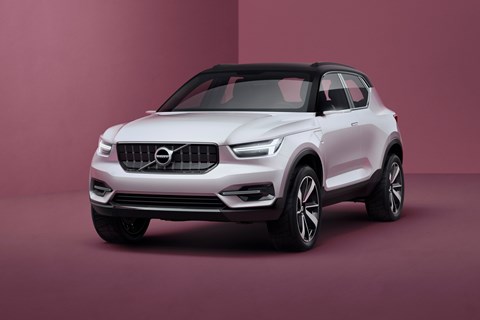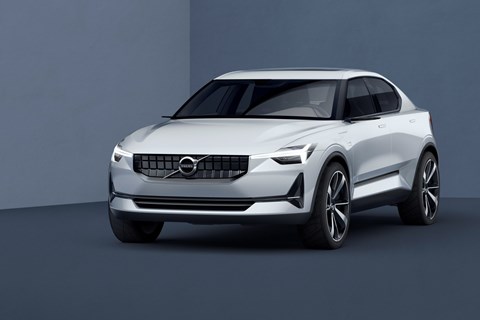► Concept 40.1 and 40.2 revealed today
► Preview next-generation 40-series models
► New CMA platform unlocks EV possibilities
Volvo has unveiled two concept cars to introduce its new CMA platform, the structure that will underpin its new family of medium-sized C-segment models due in 2017.
Named Concept 40.1 and Concept 40.2, the two different design studies revealed at Volvo’s Gothenburg HQ give us a good idea of what to expect from the company’s upcoming XC40 – a small SUV – and a potential notchback partner to the next-generation V40 hatchback.
Concept 40.1 and 40.2: two very different takes on the same platform
The 40.1 concept, pictured first in the gallery, previews the upcoming XC40 compact SUV. It will be the first production car built upon the fresh CMA [‘Compact Modular Architecture’] platform and will grant Volvo access to the lucrative global small SUV market.
Mixing the XC90’s luxury sheen with more manageable pricing and dimensions could be a very profitable recipe. ‘A [small] SUV has been top of our wishlist,’ says company president Håkan Samuelsson. Volvo says the 40.1 Concept is packaged with a higher driving position than a typical crossover, for a more authentic SUV feel.
The Concept 40.2, meanwhile, is a more unusual proposition – a little longer than a typical C-segment hatch, it combines a saloon-style notchback roofline with a hatchback tailgate and a raised, crossover-like stance. The stretched height also allows more space to package its floor-mounted battery pack – as the Concept 40.2 is a pure EV.
While the XC40 is a nailed-on cert for production, and will look an awful lot like the 40.1 concept shown here, the 40.2’s future is less clear. Depending on who you speak to at Volvo, it’s either a pure design study to show the versatile body style possibilities of the new CMA platform, or a preview of a similarly proportioned production car that could sit alongside a conventional hatchback successor to the V40 – or even replace the hatchback in Volvo’s range altogether.
‘We would not put that car on show if we did not think that we could put it into production,’ says Volvo’s design boss Thomas Ingenlath. ‘I really hope that we have the potential not to split the 40-series world into typical segments. The 40.2’s notchback roof gives it a distinctive front three-quarter view, with the shoulder sticking out like a muscle. I really hope we can make it. That is something that we can pull off.’

Introducing Volvo’s new 40 family
The XC40 will be the first of the new CMA models, and enter production in 2017. Volvo has long planned to produce a more petite SUV, and now it’s finally in the works.
3×3 – Volvo’s future product grid
Volvo’s short-to-mid-term product plans revolve around three models for each of the 40, 60, and 90-series lines, says senior vice president for r&d Peter Mertens.
The 90 series is already established, upon the larger ‘SPA’ (Scalable Product Architecture) platform, with the XC90 SUV, S90 saloon and V90 estate. The current aging 60 series (V60, S60 and XC60) is next in line for renewal, using a development of the SPA platform.
‘We are not going to follow the race the Germans are having with themselves, [saying] “we are going to be in every niche”’, says Mertens.

Volvo’s new CMA platform: the details
As its name implies, the modular, front-wheel-drive-based CMA structure is designed to be as flexible as possible. With provision for battery packaging in the backbone-like central section, there will be pure electric, plug-in hybrid, and conventional internal combustion engine models with negligible differences in interior and luggage space between variants.
The CMA platform is shared with Volvo’s Chinese owners Geely. Upcoming Geely models will share the same dimensions, front and rear axles and other hard points as Volvo’s CMA cars, but Volvo won’t be sharing its electrical systems and is adamant there will be no design crossover between the two brands – Geely’s CMA-based models won’t be rebadged Volvos.
What powertrains will the CMA cars feature?
Variants will include:
- Front-wheel drive, conventional internal combustion engine
- Front-wheel drive plug-in hybrid – called ‘Twin Engine’ by Volvo
- Mechanical all-wheel drive with a conventional propshaft
- Pure electric BEV [Battery Electric Vehicle]
‘An electric powertrain program including both a new compact Twin Engine plug-in hybrid as well as a pure electric car are central to the CMA architecture,’ says Volvo president Håkan Samuelsson.
Certain CMA models will feature a new family of three-cylinder petrol engines, to be produced in China in conjunction with parent company Geely.
Peter Mertens, senior vice president for r&d at Volvo says: ‘current three-cylinders have performance you would have dreamed of for a four-cylinder some years ago, so we can continue to stretch that to extreme power and torque figures.’
‘We also plan to put it into the 60s [60-series cars],’ Mertens adds. ‘We will not do a diesel three-cylinder. We question whether it’s a good idea.’
The ‘Twin Engine’ plug-in hybrid variant will pair the three-pot petrol with an electric motor flanged on a new seven-speed double-clutch transmission, a powertrain option likely to be badged ‘T5’.
Volvo promises ‘extremely low’ CO2 figures. Rather than the 90 platform’s T8 Twin Engine models which boast supercar-humbling performance figures, the C-seg T5 system is ‘not about performance, and more about low emissions,’ says Mertens.

Will there be go-faster Polestar models on the CMA platform?
‘Why would we invest in the brand [Volvo recently took ownership of tuning and motorsport specialists Polestar] if we were not going to use it?’ says Mertens. Take from that what you will…
Any even smaller platforms on the way?
No – Volvo’s existing SPA and new CMA structures will underpin all of Volvo’s new models for the immediate future.
What about Volvo’s electric car plans?
In 2019, Volvo will launch a pure battery-electric vehicle (BEV) based upon the larger SPA platform. Although not officially confirmed, it will almost certainly be available as a variant extension of a model in the existing 90-series range [XC90, S90 and V90.]
‘Pure electric vehicles do not have to be ugly. That is why we put PHEV technology into our normal vehicles. We will continue to do that. It doesn’t have be shouting out “I’m different.” It should be just a choice,’ says Mertens.
Company insiders have today confirmed a CMA BEV will follow. It will have a range in the region of 350km – precise numbers are still being determined as the car’s development continues.
Volvo says it aims to have sold a cumulative total of 1million electric vehicles globally by the year 2020 (a figure which includes hybrid vehicles created to date). None of its future electric vehicles will be ‘niche vehicles’ – all will be models intended to be built and sold in high volumes.
‘We strongly believe electrification will now take off. We will do the next step soon. We believe that is the right strategy going into the end of this decade,’ says Mertens.
Read CAR magazine’s Volvo reviews here
